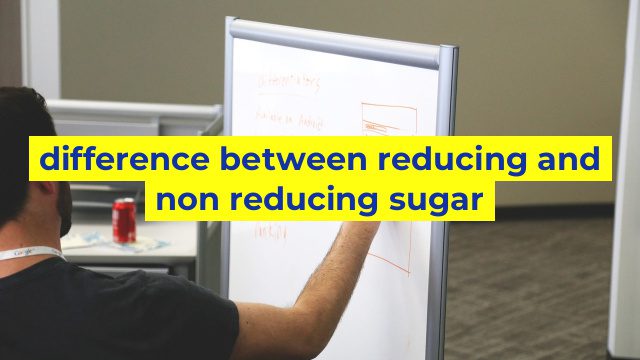Understanding the Difference between Reducing and Non-Reducing Sugars
Sugar is an important ingredient in many food and beverage products that we consume daily. However, not all sugar types are the same. Two of the major types are reducing and non-reducing sugars which have different chemical compositions and properties. In this article, we will delve deeper into these sugars and understand their differences.
What are Reducing and Non-Reducing Sugars?
Reducing sugars are those that contain a free aldehyde or ketone functional group. The aldehyde or ketone group can react with other compounds to reduce their chemical compositions. This process is known as oxidation-reduction (redox) reaction. All monosaccharides such as glucose, fructose, and galactose are reducing sugars. Disaccharides such as maltose and lactose also have reducing properties.
On the other hand, non-reducing sugars do not have a free aldehyde or ketone functional group. Instead, they have hemiacetal or hemiketal groups that do not undergo oxidation-reduction reactions. Common examples of non-reducing sugars are sucrose and trehalose.
The Differences between Reducing and Non-Reducing Sugars
One of the main differences between reducing and non-reducing sugars is their reactivity. Reducing sugars are chemically reactive and can undergo oxidation-reduction reactions with other compounds. This makes them useful in several food and beverage applications such as browning reactions in baked goods and flavor development in fermented products. Non-reducing sugars, however, are less reactive and don’t readily react with other compounds in food systems.
In terms of taste, reducing and non-reducing sugars also differ. Reducing sugars can taste sweet or acidic, depending on their chemical composition. Non-reducing sugars, on the other hand, are typically sweeter than reducing sugars. Hence, they are used as sweeteners in many food products.
Another difference between reducing and non-reducing sugars is their solubility. Reducing sugars are more soluble in water than non-reducing sugars. This property makes them useful in many food applications such as syrups, confectionery, and beverages. Non-reducing sugars, however, are less soluble in water and often form crystals when dissolved in water.
Conclusion
In summary, reducing and non-reducing sugars have different chemical compositions, properties, and uses. Reducing sugars are more reactive and less sweet than non-reducing sugars. They are commonly used in food applications such as browning reactions and flavor development. Non-reducing sugars, on the other hand, are sweeter than reducing sugars and are used primarily as sweeteners in food products. Understanding the difference between these two types of sugars is essential for food scientists and manufacturers to make the right choices in formulating food and beverage products.
Table difference between reducing and non reducing sugar
| Parameter | Reducing Sugar | Non-Reducing Sugar |
|---|---|---|
| Definition | A sugar that has an aldehyde or ketone functional group that can reduce other compounds. | A sugar that does not have an aldehyde or ketone functional group and therefore cannot reduce other compounds. |
| Examples | Glucose, fructose, maltose, lactose | Sucrose |
| Structure | The reducing end of the sugar molecule has an open aldehyde or ketone group. | The non-reducing end of the sugar molecule has a glycosidic bond instead of an open aldehyde or ketone group. |
| Chemical Properties | Can reduce other compounds and react with certain chemical reagents (e.g. Benedict’s solution). | Cannot reduce other compounds or react with certain chemical reagents (e.g. Benedict’s solution). |
| Use in Cooking/Baking | An important ingredient in browning reactions and caramelization, as well as providing sweetness and helping to stabilize baked goods. | A common source of sweetness in baked goods, but cannot participate in browning reactions or caramelization. |

